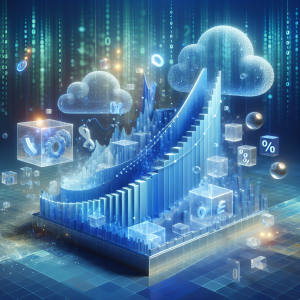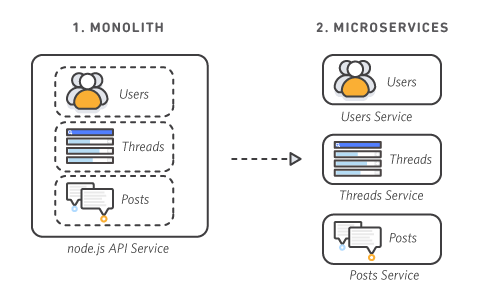

Microservices is not just a buzzword. With the likes of bigger modern forums like Amazon and Netflix taking over the software architecture approach of microservices, it has become quite the reality for many others.
Microservices are basically a cognitive architectural and organizational approach to software development. It allows the software to be structured loosely, making the components independent yet allowing communication over well-defined APIs. This categorization allows each department to focus on each service at a granular level as smaller, self-contained software teams own them.
Hence, there is no denying that all these platforms have migrated from their dated monolithic architecture to microservices architecture for many beneficial reasons and not just as an upgrade to newer technology.
For instance, microservices are categorized based on different business functions. So the developmental team can easily focus on each category of specific services. Moreover, they are conjoined yet independent, making microservices easier to update in comparison to traditional monolithic architecture. The smaller components are compatible yet can break apart to work upon separately. Consequently, this makes the microservices architecture more flexible for the platform as each of the varying services is only responsible for their intended task.

Safe to say, the essence of microservices architecture is in the independence it offers, which is why it has become increasingly popular among the software giants. The whole independent yet loose coupling is exactly the kind of structure anyone would desire for a complex enterprise solution like Amazon or eBay. You get a wider range of technology stacks to choose from while identifying hot services and scaling them for the level of ease to difficulty.
There are three main types of Microservices:
- Stateless – computing
- Persistence – storage
- Aggregator – choreography
Stateless Microservice
Stateless microservices are the better candidates among the various categorizations of each building block of the distributed software system. As the name indicates, these microservices are literally “stateless” – as in they do not maintain a singular session state amidst the requests being sent out. For instance, if one of the service blocks is being removed, the impact would be limited to the granular fraction and not affect the holistic processing for the logic service. Therefore, distributed system software tends to prefer stateless microservice. The following characteristics summarize the microservice type:
- Simple processors (converters, translators, etc.)
- No dependence on other microservices
- No local data storage (disk I/O)
- Caching
- Fail Fast
Persistence Microservice
One of the basic set of principles that data managing for microservices architecture offers is that as every microservice is responsible for managing its own data, elements like data integrity and data consistency tend to become a critical challenge. As each of the microservices gets updated as and when needed, the updates are completely isolated from others and the more granular yet affecting the whole software system. Thus, this approach is usually determined as the polyglot persistence or, more commonly, as the Persistence microservice. It is in its simplest form the use of multiple data storage technological categories within a single application API. The following characteristics adhere to persistence microservice:
- Simple (local) storage (reads and/or writes)
- Disk I/O dependent
- Possibly VM, one-U, dependent
- Caching
- Fail Fast
- Timeout
- Circuit Breaker
- Steady State
Aggregator Microservice
Aggregator microservice is the approach of microservice that allows the system software to collect pieces of data blocks from other various microservice blocks and return the aggregate for further processing. As the name suggests, the aggregator microservice is basically a processing method through the aggregate of the system software to achieve optimum functionality that is required by the application API. In the industry dynamics of using the aggregator microservice, you split the complex application building blocks into independently usable services. The following qualities summarize aggregator microservice.
- Depends on other distant microservices
- Network dependent
- Usually Disk I/O dependence, too
- Caching
- Fail Fast
- Timeout
- Circuit Breaker
- Steady State
- Handshaking
- Bulkhead
In Conclusion,
There are multiple approaches to data management, and there is no singular approach that adheres to every different type of enterprise case. However, the following generic guideline, along with the three main types of microservices, can easily take you through the successful integration of the system software.
- Take consistency where possible.
- When strong consistency is required, one service can be used to expose through an API.
- For transactions, using patterns that help in data consistency throughout several services is viable to use.
- Storing data that the service needs is the right way to go about it.
- It is essential to give importance to whether your services are coherent and loosely coupled.
If you are looking for a reliable source to help you create a highly successful and qualifies system software, look no further. We at Enterprise Cloud Computing are committed to delivering the exact code capability that you seek and, as such, offer unlimited code updates. Complete satisfaction is our guarantee!
- Custom Software
Our code specifications are fully documented for your ease of the support.
- Mobile Application
Enterprise custom functionality from modern smartphones.
- Artificial Intelligence
Gain deep knowledge from machine learning analytics.
- Software Testing
Validated for quality, security, and scale.
Recent posts


Enhancing Support with Intelligent AI Bots
June 25, 2025
No Comments

Maximizing Business Potential with AI Agents
June 24, 2025
No Comments
What they say
"Working with Enterprise Cloud Services AI has been a game-changer for our business. Their expertise in AI algorithms and innovative solutions has significantly boosted our online presence and organic traffic, resulting in a substantial increase in leads and conversions."
John DoeAccountant, Colibri
"We couldn't be happier with the AI-powered applications they developed for us. Their dedication to optimizing our website's SEO performance has not only improved our search engine rankings but also enhanced the overall user experience, making Enterprise Cloud Services AI an invaluable partner in our digital journey."
Max PowellCEO, Falcon
"Enterprise Cloud Services AI truly understands the nuances of Healthcare and AI integration. Thanks to their cutting-edge solutions, we've seen a remarkable efficiency and accuracy in data lake queries, ultimately driving more revenue for our business. Their expertise is second to none!"
Alex PaloOwner, Eagle
from the author
- Utilizing Azure for Cost-Efficient AI Management June 25, 2025
- Enhancing Support with Intelligent AI Bots June 25, 2025
- Maximizing Business Potential with AI Agents June 24, 2025
- Advancing DevOps Practices Through AI Tools June 24, 2025
- Leveraging Cloud Tech for Business Agility June 23, 2025
Subscribe Newsletter
Stay in the know and join our vibrant community – subscribe to our newsletter for the latest updates, insights, and exclusive offers delivered straight to your inbox!